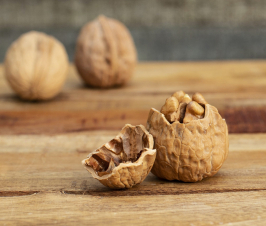Walnuts Lower Food Cravings by Promoting a Feeling of Fullness when Consumed
A recent study looked at the ability for walnuts to curb appetite.1It is generally accepted that walnuts lower food cravings, by promoting a feeling of fullness when they are consumed. Nuts in general seem to serve as a great snack that provides satiety; likely due to the oil content in them. Oils, or fats, trigger satiety mechanisms in the intestine, which is one potential aspect of walnut’s effect on food cravings. This is well known, but there seems to be a stronger effect from walnuts than other nuts, and researchers looked at what is happening inside the brain that could account for this effect.
The Study
The study took obese individuals in a “live-in” environment and gave them either a smoothie with 48 grams of walnuts, or a placebo-smoothie with no walnuts. Both smoothies were designed to taste the same. After consumption, subjective assessments of hunger as well as functional magnetic resonance imaging (fMRI) scans were conducted. The scans were conducted while participants were shown pictures of either highly desirable foods, such as hamburgers, ice cream or potato chips, less desirable foods, such as vegetables, or neutral objects, such as furniture.
Right Insula Activated in the Walnut Group
The subjective questionnaires confirmed that the walnuts did have a negative effect on appetite, that the individuals with the walnut smoothies had less food cravings than the placebo group. The fMRI scans revealed an area of the brain, called the right insula was activated in the walnut group. This brain region is known to regulate hunger signals, and is likely responsible for the increased ability to distinguish between hunger or satiety after eating the walnuts.
Add Walnuts to the List of Foods to Help Quash Hangry Fits
The consumption of foods which help curb hunger cravings, while offering a nutrient dense snack, are wonderful changes which can help obese individuals, or individuals with type 2 diabetes. It’s also good to know foods which may help stave off the “hangry” on your next road trip.
Source
- Farr OM, Tuccinardi D, Upadhyay J, Oussaada SM, Mantzoros CS. Walnut consumption increases activation of the insula to highly desirable food cues: A randomized, double-blind, placebo-controlled, cross-over fMRI study. Diabetes Obes Metab. 2017.
Image Copyright: <a href=’https://www.123rf.com/profile_ninamalyna’>ninamalyna / 123RF Stock Photo</a>
 Node Smith, associate editor for NDNR, is a fifth year naturopathic medical student at NUNM, where he has been instrumental in maintaining a firm connection to the philosophy and heritage of naturopathic medicine among the next generation of docs. He helped found the first multi-generational experiential retreat, which brings elders, alumni, and students together for a weekend camp-out where naturopathic medicine and medical philosophy are experienced in nature. Three years ago he helped found the non-profit, Association for Naturopathic ReVitalization (ANR), for which he serves as the board chairman. ANR has a mission to inspire health practitioners to embody the naturopathic principles through experiential education. Node also has a firm belief that the next era of naturopathic medicine will see a resurgence of in-patient facilities which use fasting, earthing, hydrotherapy and homeopathy to bring people back from chronic diseases of modern living; he is involved in numerous conversations and projects to bring about this vision.
Node Smith, associate editor for NDNR, is a fifth year naturopathic medical student at NUNM, where he has been instrumental in maintaining a firm connection to the philosophy and heritage of naturopathic medicine among the next generation of docs. He helped found the first multi-generational experiential retreat, which brings elders, alumni, and students together for a weekend camp-out where naturopathic medicine and medical philosophy are experienced in nature. Three years ago he helped found the non-profit, Association for Naturopathic ReVitalization (ANR), for which he serves as the board chairman. ANR has a mission to inspire health practitioners to embody the naturopathic principles through experiential education. Node also has a firm belief that the next era of naturopathic medicine will see a resurgence of in-patient facilities which use fasting, earthing, hydrotherapy and homeopathy to bring people back from chronic diseases of modern living; he is involved in numerous conversations and projects to bring about this vision.

















